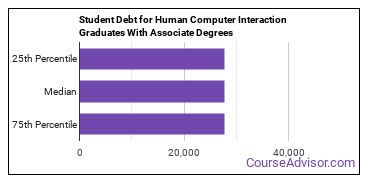Associate Degrees in Human Computer Interaction
Education Levels of Human Computer Interaction Majors
During the most recent year for which data is available, 61 people earned their associate degree in human computer interaction. This earns it the #172 spot on the list of the most popular associate degree programs in the nation.
The following table shows the number of diplomas awarded in human computer interaction at each degree level.
| Education Level | Number of Grads |
|---|---|
| Master’s Degree | 1,048 |
| Bachelor’s Degree | 892 |
| Basic Certificate | 247 |
| Associate Degree | 61 |
| Graduate Certificate | 53 |
| Doctor’s Degree | 23 |
Earnings of Human Computer Interaction Majors With Associate Degrees
The median salary for graduates holding an associate degree in human computer interaction is $32,253. This number may vary for a lot of reasons. For instance, you may decide to move to a location where people with your degree are rare and make more money. To get a better picture, earnings for this category of people can range from a low of $32,253 to a high of $32,253.

Student Debt
The median student debt for graduates holding an associate degree in human computer interaction is $11,954. The length of time it takes you to graduate and what college you attend can affect this number quite a bit. The chart below shows the range of accumulated debt loads. On the high side of the range, $11,954 is the debt load, and the debt load on the low side is $11,954.

Those students who are paying back their debt on a 10-year repayment plan have a median monthly payment of $142.
Student Diversity
More men than women pursue associate degrees in human computer interaction. About 88.5% of graduates in this field are male.
| Gender | Number of Grads |
|---|---|
| Men | 54 |
| Women | 7 |

The racial-ethnic distribution of human computer interaction associate degree students is as follows:
| Race/Ethnicity | Number of Grads |
|---|---|
| Asian | 1 |
| Black or African American | 7 |
| Hispanic or Latino | 12 |
| White | 35 |
| International Students | 0 |
| Other Races/Ethnicities | 6 |

Most Popular Human Computer Interaction Programs for Associate Degrees
There are 3 colleges that offer an associate degree in human computer interaction. Learn more about the most popular 3 below:
Full Sail University tops the list of the most popular school in the U.S. for human computer interaction majors who are seeking their associate degree. Each year, around 24,600 students seeking various degrees attend the university. The average in-state tuition for full-time undergraduates is $26,417 per year, while in-state graduate students, on average, pay $19,401 per year. During the most recent year for which we have data, 145 people received their associate degree in human computer interaction from Full Sail University. Around 38% of these students were from an underrepresented racial-ethnic group, and 9% were women. Data shows that Full Sail University graduates that hold this degree go on to make a median salary of $32,253.
The 2nd most popular school in the country for human computer interaction majors who are seeking their associate degree is Raritan Valley Community College. Each year, around 7,000 students seeking various degrees attend the university. During the most recent year for which we have data, 2 people received their associate degree in human computer interaction from RVCC. Of these students, 40% were women and 40% were members of underrepresented racial-ethnic groups. Data shows that RVCC graduates that hold this degree go on to make a median salary of $32,253.
Explore Major by State
Alabama
Arkansas
Connecticut
Florida
Idaho
Iowa
Louisiana
Massachusetts
Mississippi
Nebraska
New Jersey
North Carolina
Oklahoma
Rhode Island
Tennessee
Vermont
West Virginia
Related Majors
Below are some popular majors that are similar to human computer interaction that offer associate degrees.
| Major | Annual Degrees Awarded |
|---|---|
| Biological & Physical Science | 23,920 |
| Other Interdisciplinary Studies | 4,514 |
| Behavioral Science | 789 |
| Interdisciplinary Studies | 644 |
| Natural Sciences | 607 |
References
*The racial-ethnic minority student count is calculated by taking the total number of students and subtracting white students, international students, and students whose race/ethnicity was unknown. This number is then divided by the total number of students at the school to obtain the percentage of racial-ethnic minorities.
- College Factual
- National Center for Education Statistics
- O*NET Online
- Bureau of Labor Statistics
- Image Credit: By Intel Free Press under License
More about our data sources and methodologies.

